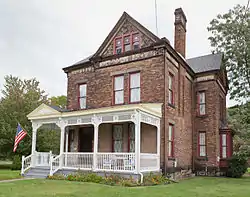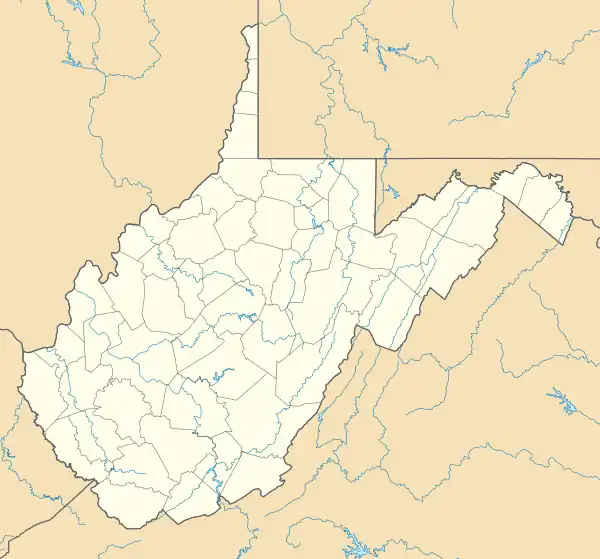Marshall House (New Cumberland, West Virginia)
Marshall House, also known as McNeil House, is a historic home located at New Cumberland, Hancock County, West Virginia. It was built in 1887 and is a 2+1⁄2-story, Queen Anne style brick dwelling. It was built by West Virginia State Senator Oliver S. Marshall (1850-1934) and remained his home until his death.[2]
Marshall House | |
 Marshall House, September 2012 | |
  | |
| Location | 1008 Ridge Ave., New Cumberland, West Virginia |
|---|---|
| Coordinates | 40°29′47″N 80°36′16″W |
| Area | 0.8 acres (0.32 ha) |
| Built | 1887 |
| Architect | Smith |
| Architectural style | Queen Anne |
| NRHP reference No. | 01000263 [1] |
| Added to NRHP | March 12, 2001 |
It was listed on the National Register of Historic Places in 2001.[1]
The house is operated as the Hancock County Museum.
The Marshall House is an elegant 19th century two and one half story Queen Anne style
residence built in 1887 located on Ridge Avenue in New Cumberland, West Virginia
overlooking the Ohio River. The house was built in 1887 by lawyer and West Virginia State
Senator, Oliver Marshall. The Marshall House has remained in the Marshall family
since its construction. The house was built in 1887 by Oliver Marshall.
Exterior
The two and one half story, three bay brick residence has an asphalt roof and stone foundation.
All windows are double-sash with limestone sills and lintels. Windows have interior wood
shutters. Front gable roof end to right has three Queen Anne windows, decorative wood blocks
in peak and a stringcourse under the eaves. There are double brackets at the comers. Gable has
diamond lights. Brick sidewalk has the word "ETNA" imprinted in bricks.
West (Front) Facade
The front facade has 3 bays. There is a full porch with wood posts with spools and pierced wood
block effect brackets. The porch has a shed roof with a left side pedimented gable with a fan
effect oversteps. The double front door has a transom with narrow Queen Anne window with
colored lights in upper sash. The doors are heavily carved and there is the initial " M carved on
the bottom of each door. The interior single door has a cut glass zinc camed window. There are
paired windows to the right and above on second floor, with a single window on left.
South Facade
The south facade has four bays. There is an integral brick chimney with decorative brickwork.
The southeast comer has a wooden porch with turned wood columns and decorative woodwork
around the shed roof. The middle of the facade has a shallow, L-shaped section with a front
gable roof that has decorative wood blocks in the peak and a first floor, hipped roof, bay window.
The hipped roof on this elevation has original slate.
East Facade
The east facade has two bays and an integral, decorative brick chimney. The ease facade shares
the southeast comer porch with south facade
North Facade
The north facade has four bays and an L-shaped middle section with a fiont gable roof. The peak
of the roof has three one over one double-hung sash windows and decorative block woodwork.
The first floor has small colored glass window on northwest side.
Interior - First Floor
The first floor has ornately carved, cherry, woodwork throughout. The entrance hall has an
interior, beveled glass door. There is a wooden, carved staircase leading to the second floor. In
addition, there is a second stairway in the kitchen. In the dining room there is a built in wood
cabinet in the closet and an alcove with carved wood trim. Wood pocket doors kame the
entrance to the living room. The living room, dining room, and library also contain omately
carved mantels surrounding the fireplace in each room. These rooms also have interior wood
shutters.
Interior - Second Floor
The second floor contains five bedrooms and one bathroom. All rooms on this floor have
wooden doors and transoms. The floors are hardwood. Over two of the bedroom doors the
names of Oliver Marshall's children by his first wife, John and Olive, were etched into the
transoms. There is a staircase leading to the finished attic.
Interior - Attic
The attic is finished and has hardwood floors. The attic was used mainly as a playroom for
Oliver Marshall's children.
Exterior – Garage/Storage Shed
One bay, wood, garage storage shed with front gable roof. c. 1955. Noncontributing.
The Marshall House on historic Ridge Avenue was built by West Virginia State Senator Oliver
Marshall in 1887. It qualifies under Criterion B because of Marshall's role in government and
the political history of West Virginia. The Marshall House also qualifies under Criterion C as an
example of late 1 9'h Century Queen Anne architecture. The house has been owned by members
of the Marshall family since its construction. The period of significance is 1887-1934 when it
was the home of Senator Oliver Marshall.
Historical Significance
The Marshall House was built by West Virginia State Senator Oliver Marshall, a descendant of
one of Hancock County's leading families. Oliver Marshall was born in Fairview, now New
Manchester, on September 24, 1850. He was the great-grandson of the pioneer Aaron Marshall,
who came from east of the mountains, from somewhere in Virginia. He is thought to have been a
soldier for Braddock and Washington in the famous campaign of 1755. About 1760 he came to
what is now Hancock County, WV. His land was part of the Johnson Survey, granted in 1775,
when Patrick Henry was governor of Virginia. The grant was for 7,000 acres, but when it was
surveyed it measured 8,100 acres. Of this Aaron Marshall was assigned 205 acres at ten shillings
an acre, payable in whiskey at five shillings a gallon, flour and other forms of currency of the
day. Aaron Marshall had the fourth house on the tract. The original record of title is at
Louisville, Kentucky. The town of Newel1 stands on part of the original grant. In his minutes
George Washington mentions the waterfalls where his tract borders the Ohio River, but the land
of Aaron Marshall was some five miles northeast from that stream.
Aaron Marshall continued to live on his Hancock County land until his death 1826. He was a
Baptist and frequently preached in the Kings Creek area, where he is buried.
Aaron Marshall's son, John, was born in 1782 and died in 1859, spending his entire life in
Hancock County. He was a member of the Presbyterian Church.
John Marshall's son, James G. Marshall, was born at old Fairview, Hancock County on
November 2 1, 1826 and died October 6, 1902. He left the farm, did considerable surveying,
became an attorney, and for twenty-four years was the prosecuting attorney of Hancock County.
He was buried in the old Presbyterian churchyard at Fairview. His wife was Lavina Miller,
daughter of John Miller and granddaughter of David Miller. David Miller settled on Tomlison
Run, where he owned 400 acres, secured from Dorsey Pentecost, one of the two last judges who
held court at Pittsburgh under the authority of the British crown. David had the first house in
Gas Valley, and died in 1835, in his ninety-ninth year. His son, John, spent his life as a farmer at
the old place, and his daughter, Lavina was born there. She died when about sixty years old.
Her three children are: Oliver S., E.D. Marshall, an attorney at Santa Clara, CA, and Ila, who
mamed Dr. J.W. Walton.
Oliver S. Marshall attended West Liberty Normal School and graduated from Bethany College in
1878. Marshall served as a trustee of that college for many years. From 1880 to 1885 Marshall
was principal of the New Cumberland Grade School. In 1884 he was elected the Clerk of the
County Court of Hancock County. He held this office until 1896 when he was elected to the
West Virginia State Senate from the First Senatorial District. That same year he was admitted to
the Hancock County bar. In 1892 Marshall served as a delegate to the Republican National
Convention. Marshall served as President of the State Senate for the 1899 session.
During his term as President of the West Virginia Senate, Marshall presided over Senate
proceedings that led to the passage of a variety of bills. Some of the issues that were decided by
the Senate and the Legislature during Marshall's term as president were incorporation of West
Virginia banks and savings institutions, establishing a procedure for West Virginia public
institutions to report to the Legislature, and reorganizing the process for the Legislature to
consider appropriations bills.
Oliver S. Marshall married Elizabeth Tarr on September 8, 1880. Elizabeth was the daughter of Campbell and Nancy Harnmond Tarr. Campbell Tarr was one of the members of the Richmond
Convention who withdrew when Virginia passed the ordinance of secession. Subsequently, Tarr became a leader in the West Virginia statehood movement.
In 1887, Oliver Marshall hired an architect named Smith to build a house on Ridge Avenue
according to Marshall's specifications. The Queen Anne style home was constructed with bricks
made in New Cumberland from local clay. The Marshall house is the finest example of
Queen Anne style architecture in New Cumberland.
Oliver and Elizabeth Marshall had two children, John and Olive. John graduated from Yale and
West Virginia University and later practiced law in Parkersburg. After the death of Elizabeth,
Marshall married Nora Householder in 1890. The Marshalls had three children: Edith, Edmond,
and Virginia. Oliver Marshall died in 1934 at the age of 66. After his death, Marshall's
daughter, Virginia Marshall, lived in the house and taught school in New Cumberland for forty
years. She resided in the Marshall house until her death in 1997.
Summary
The Marshall/McNeil House is significant under Criterion B because it was the home of one of
New Cumberland's leading politicians, Oliver Marshall. During his lifetime, Marshall served
Hancock County as a teacher, lawyer, West Virginia State Senator, and President of the West
Virginia Senate. The house was Oliver Marshall's home from the time is was built in 1887 till
his death in 1934. The Marshall/McNeil House also qualifies under Criterion C as an excellent
example of late 19th century Queen Anne architecture
Bibliography
Bicentennial Committee. A short History of New Cumberland (Hancock Courier Printing
Company, 1939)
Hancock County Deed Books and Maps. Hancock County Courthouse. New Cumberland, West
Virginia.
Sanborn Fire Insurance Maps, (New York, Sanborn-Perris Map Co., Limited) 1890, 1897,
1901, 1910, and 1921.
Newton, J. H. History of The Pan-Handle: Being Historical Collections of the Counties of Ohio,
Brooke. Marshall and Hancock, West Virginia. Compiled and written by J. H. Newton,
G. G. Nichols, and A. G. Sprankle. Edited by J. H. Newton. Publisher: Wheeling, W.Va.,
J.A. Caldwell, 1879
History of the Upper Ohio Valley, with family history and biographical sketches: a statement of
its resources, industrial growth and commercial advantages. Madison, Wis.: Brant &
Fuller, 1890.
References
- "National Register Information System". National Register of Historic Places. National Park Service. March 13, 2009.
- Christy Venham (October 2000). "National Register of Historic Places Inventory Nomination Form: Marshall House" (PDF). State of West Virginia, West Virginia Division of Culture and History, Historic Preservation. Retrieved 2011-06-20.
External links
- Hancock County Museum - official site
